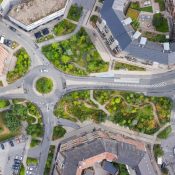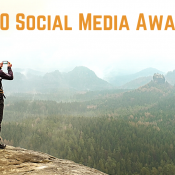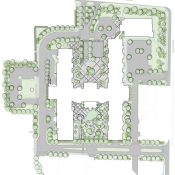Author: Land8: Landscape Architects Network
Social Media Awards in Landscape Architecture 2024 – Winners!
Here are the winners of the 7th Annual Social Media Awards in Landscape Architecture presented by Land8 and the American Society of Landscape Architects! Social media has the power to significantly increase the awareness and importance of the profession of landscape architecture, and Land8 and ASLA believe industry leaders in social media should be recognized and promoted. Be sure to follow the winners to help grow and promote the profession!
Top 10 Social Media Accounts – LANDSCAPE ARCHITECTURE FIRMS
1. Design Workshop, Inc. – Instagram | LinkedIn
We use social media to promote the value of landscape architecture and its role in creating resilient, connected, and beautiful spaces. Our posts highlight DW Legacy Design®—balancing environmental sensitivity, community connection, artistry, and economic viability. We aim to educate, inspire, and engage a broad audience. In 2024, Instagram followers grew by 16.7% and engagement rose 921.5%, while LinkedIn followers grew 14.3% with engagement up 624.6%.
2. Arcadia Landscape Architecture – LinkedIn | Instagram
Arcadia’s purpose is to partner to enrich community and Country. Our social media content shares the work and culture of a landscape architecture and urban design practice operating across Australia, shaping a future where every landscape tells a story of innovation, sustainability, and cultural connection. We are committed to increasing the representation of Indigenous Australians in the built environment and we hope to educate and inform as we share this journey through our content.
3. Fletcher Studio Landscape Architecture – Instagram | LinkedIn | YouTube | Blog
We offer a behind-the-scenes look into what inspires us. It’s true to who we are, and reflects our interests in art, music, exhibitions, gathering, science–and sometimes bizarre phenomena. We look, celebrate what we see, and showcase often overlooked, tiny delights. Rooted in visual storytelling, our colorful social platform celebrates the personal touches that feed our creativity and live on in our work. We believe in the power of public space for everyone, and share our joy in designing it.
4. Hitchcock Design Group – Instagram | LinkedIn | Facebook | Blog
We think of landscape architecture as storytelling at scale. Social media helps to further our stated purpose: To improve people’s lives through meaningful interactions with creative outdoor spaces and places. Our social channels showcase the people, process and projects that define our values of Design Excellence, Collaboration Equity and Life Balance, providing a venue for networking, education and celebration.
5. Oehme, van Sweden | OvS – Instagram
Our social media presence has always emphasized possibilities and creativity. Drawing from built work, our daily activities and on-going projects we engage our audience with our distinctive style and bountiful gardens. We pride ourselves on joyful, inspired places. No two days are alike at our office and similarly, no content is repeated.
6. DTJ DESIGN – Instagram | LinkedIn | Facebook
Our social media is a pillar of how we develop the awareness of our brand. Using the platforms to promote the work we do for our clients as well as promote the DTJ designers. Although we are disciplined in landscape architecture, we are also disciplined in architecture and planning services. Making us multifaceted in several segments, public work, themed attractions, community design and amenities, resorts and hospitality, and more!
7. Spackman Mossop Michaels – Instagram
SMM sees social media as a critical connection to our collaborators, clients, and colleagues. In 2024, we focused on elevating the people behind our work as they are often an unseen part of our projects. Our community partners are the foundation of our practice. Their stories both motivate us on a personal level while also inspiring our approach to climate and environmental justice in our work. Showcasing the faces behind our work emphasizes that landscape architecture is about people.
8. McCullough Landscape Architecture – Instagram | LinkedIn | YouTube
At McCullough, we elevate landscape architecture and celebrate our people through visually stunning content. We engage audiences with human-centered storytelling, showcasing team stories, project highlights with professional photography, designer renderings, and videos like “Studio Chats” with collaborators. By blending thought leadership, storytelling, and vibrant visuals, we spark conversations about the importance of creating sustainable, thriving communities, starting with landscape.
9. The MBTW Group – Instagram | LinkedIn | Facebook
Our social media strategy has been built around sharing information about our projects and our office culture with the intention of demonstrating the capability and diversity of the Landscape Architectural profession. By highlighting our projects, team specialties, and community collaborations, we aim to inspire others and promote the value of sustainable, creative, vibrant, inclusive, and resilient spaces.
10. Clinton + Ries Landscape Architects – Instagram | LinkedIn | Facebook
We use social media to showcase our work and raise awareness for thoughtful, environmentally conscious landscape architecture. By fostering connections with industry professionals and highlighting collaborations, we aim to educate and inspire our audience. Our focus is on sharing discoveries, promoting sustainable practices, and encouraging a deeper appreciation for the impact of design on our environment and communities.
Top 10 Social Media Accounts – INDIVIDUAL LANDSCAPE ARCHITECTS
1. Zixu Qiao – Instagram | YouTube
I use social media to educate and inspire the global design community by sharing innovative tutorials, mapping techniques, and visualization tips through LandSpace Architecture. My content highlights sustainable solutions, AI integration, and design approaches for climate resilience. By engaging followers through platforms like Instagram and YouTube, I promote the value of landscape architecture, foster collaboration, and empower young designers to address pressing environmental challenges.
2. Eric Arneson – Instagram | Threads | YouTube
Eric Arneson, a Landscape Architect, provides an inside look at the design process of his California-based firm, Topophyla Landscape Design. His Instagram account features an engaging blend of quick tutorials, landscape-themed memes, and insights into cutting-edge technologies such as drones, 3D scanning, and AI, highlighting his dedication to innovation in landscape architecture.
3. Nahal Sohbati – Instagram
A little bit of this & that. Showing the fun, the ugly, & everything in between. It’s not always about celebrating achievements but about embracing the lessons learned along the way. My platform breaks away from the “always pretty” & perfect practices, highlighting the fun, messy, & raw reality of design. In a world where AI delivers picture-perfect everything, what’s missing is the authenticity & honesty of the process. No formulas, no filters, just the genuine ebb & flow of the work we love.
4. Jordan Chiang – Instagram | LinkedIn
This account is focused on landscape architecture from an emerging professional’s standpoint, displaying the various aspects of my life that relate to the study and practice of it; including sketches, professional/personal works, academic engagements, conferences/professional events, interesting landscape moments, licensure, travel, etc. I hope to show a bit of what working in this field can be, particularly for minority students, and promote this field as the fascinating opportunity it is.
5. Joanna Łaska-Sochacka – Facebook | Instagram
I’m Joanna, owner of Studio S Landesign, and I’ve been designing healthy gardens for Polish families for 10 years. I hold a BSc and MSc in Landscape Architecture, alongside two therapeutic degrees. Passionate about plants and wellbeing, I promote health through horticulture. Recognized in 2020 as a Top 10 social media account by Land8, I share garden design, plant education, and charity work, including annual custom garden project auctions, inspiring sustainable living and connections with nature.
6. Camille Wildburger – Instagram
At Bylines Studio, I channel my passion for landscape architecture by providing accessible online design services and resources for homeowners, builders, architects, and designers. As a full-time public park project manager, I launched this business to make thoughtful design available nationwide. Through social media, I showcase the creative process, empower clients to transform spaces, and share insights on building a design business online, combining sustainability with modern accessibility.
7. Michelle Davis – Blog
My blog, The Botanical Texan, promotes landscape architecture by connecting design, nature, and real-world experiences. I share examples, practical tips, and ways to translate natural inspiration into design solutions. Through storytelling, I highlight underrepresented topics, showcase the profession’s impact, and advocate for its importance. By blending education, inspiration, and advocacy, I celebrate landscape architecture and inspire appreciation for its role in creating meaningful spaces.
8. Kiley Aguar – Instagram
Our social media account uses humor and relatable visuals to create disposable memes that reflect the consumable nature of the landscape. Each post blends wit, critique, and insight—designed to entertain while inspiring thoughtful reflection. By focusing on direct, easily digestible content, we strive to make complex ideas about design and landscape architecture more accessible. Our goal is simple: to help people laugh, reflect, and reconsider how design shapes the world around them.
9. Nicholas Robins – Instagram
At Plants for People, we use social media to tell the story of how landscape architecture connects people to nature. By documenting our projects from concept to completion, we show how thoughtful design transforms outdoor spaces. Whether it’s creating habitat-friendly gardens, integrating stormwater solutions, or blending with the natural beauty of the Nova Scotia coastline, our work highlights the power of design to address environmental challenges and create lasting beauty.
10. Nick Straabe – Instagram
I utilize social media to elevate firms, individuals, scholastic programs and allied organizations to bring awareness to others within the profession who might not see the works. It is also a platform that several individuals find more comfortable to have an abbreviated industry conversation. Overall objective is to galvanize the industry and bring awareness to Landscape Architecture.
Top 10 Social Media Accounts – ALLIED ORGANIZATIONS
1. Landscape First – Instagram | Facebook | YouTube | LinkedIn | Bluesky
Landscape First is an online platform that carries out a precise cultural challenge: to show the different facets that landscape can take on and the opportunities it offers us to improve the quality of life of communities and individuals. Landscape First support those who operate in the transformation of cities and the territory, from public to private entities, promoting reuse operations, care of public spaces and urban spaces, active citizenship practices and social inclusion projects.
2. Landscape Architecture Foundation – Instagram | LinkedIn
LAF uses social media to increase visibility of landscape architects, offer inspiration, and spur action on critical issues like climate change and inequity. Besides publicizing its program and funding opportunities, LAF showcases rising leaders, innovative ideas, and the far-reaching impacts of the work it supports. LAF also shares valuable resources like webinars and landscape performance case studies. Consolidating accounts allowed for more visually engaging posts and broader reach in 2024.
3. LandArch.org – Instagram | Blog
LandArch.org is a nonprofit platform dedicated to promoting landscape architecture by showcasing student projects, innovative designs, and academic work from architecture schools. Through blog posts, social media, and exhibitions, we amplify the voices of young designers and small firms, connect them with global opportunities, climate-responsive design practices. Our platform fosters community engagement and raises awareness about the critical role of landscape architecture.
4. Urbideias – Instagram | YouTube | TikTok | Facebook
Urbideias offers technical solutions and visual interpretations of urbanism and landscape, in an innovative, gentle and didactic way, combining depth, critical perspective and unique views. We believe that landscape architecture can go in addition to its utilitarian function, being able to create spaces that awaken emotions, stimulate the senses and enrich people’s lives. We main goal is to democratize the content to many people, at the same time, from different locations.
5. New York Upstate ASLA – Instagram | Facebook
NY Upstate Chapter uses social media to keep its members and followers informed about seminars and events and to foster the sense of community across its 5 sections. NYUASLA loves to celebrate its history within the state and highlight the designs with Annual Awards and Annual Instagram Takeover.
6. American Society of Landscape Architects Northern CA Chapter – Instagram | LinkedIn | Facebook | Blog
We represent 700+ landscape architects along the north coast of California. Our social media links our expansive membership, while growing public awareness. Last year we shared successes online including: our first Landscape X Symposium on cross-disciplinary topics, resources for Students and Emerging Professionals, invites to our Climate Action webinar series, JEDI events for our diverse community, and annual chapter awards. Our social media connects us, so we can pursue big ideas, together.
7. California Polytechnic State University – Instagram | Facebook
Cal Poly Landscape Architecture uses social media to promote student success and the “Learn by Doing” philosophy in an effort to attract more students to the field and celebrate what landscape architects do to make the world a better place. We post a mix of content contributed by students, staff, and faculty. Social media is also a networking tool to make connections, and we readily share relevant information from student clubs, industry partners, and the College community in our Stories.
8. Virginia Tech Landscape Architecture Program – Instagram
VTLAR uniquely highlights the world of landscape architecture by building community and sharing authentic stories from students, faculty, alumni, and friends. We showcase experiential learning, fieldwork, academics, moments, and design’s transformative impact. By leveraging social media trends, we connect with broader audiences, inspire future designers, and reveal how this innovative career shapes sustainable, equitable environments—showing prospective students how they can make a difference.
9. The Digital Journal – Instagram
The Digital Journal promotes the value of shaping urban open spaces with landscape architecture through interactive video illustrations. The page is a collection of the imagined and the unbuilt – an archive of work which puts landscape concepts at the forefront, while effortlessly conveying them to even non-professionals. We have hosted 1507 students across 78 countries in our workshops to spread awareness and further the field of landscape amongst the community of designers & other enthusiasts.
10. Vectorworks, Inc. – Facebook | Instagram | LinkedIn | X | YouTube
By engaging the community, educating users, and showcasing our software’s value. We demonstrate workflow efficiency and complex design capabilities while featuring customer success stories that validate its impact. We share industry insights, free educational resources and on-demand webinars, to encourage learning. By fostering creativity and sharing user-generated content, we build lasting relationships within the landscape architecture community through our active social media presence.
Please note that priority is given to those who have not previously received this award. View all past winners here:
2023 Winners >
2022 Winners >
2021 Winners >
2020 Winners >
2019 Winners >
2018 Winners >
Please visit Land8 again in December 2025 for next year’s call for nominations!
Nominations for Social Media Awards in Landscape Architecture 2024
Land8: Landscape Architects Network is proud to announce the 7th Annual Social Media Awards in Landscape Architecture, co-presented with the American Society of Landscape Architects (ASLA). Established as an online hub for landscape architecture professionals, Land8 has evolved into a vibrant international community, bringing together not only practicing landscape architects but also enthusiasts and learners eager to explore the field. Recognizing the transformative role of social media in amplifying the visibility and significance of the profession, Land8 and ASLA are dedicated to celebrating and promoting industry leaders who excel in leveraging these platforms.
PREVIOUS WINNERS
2023 | 2022 | 2021 | 2020 | 2019 | 2018
AWARDS
Up to ten (10) awards will be given and ranked in each of the following categories:
- Landscape Architecture Firms
- Individual Landscape Architects (or landscape designer with landscape architecture degree or student in landscape architecture)
- Allied Partners (those supporting work related or promoting landscape architecture, such as nonprofits, associations, universities, or manufacturers/suppliers)
Awardees will be featured on a list of “Best Social Media Accounts in Landscape Architecture 2024”, promoted through our extensive network, and our followers will be encouraged to follow the awarded accounts.
CRITERIA
Land8 will judge social media accounts primarily on Promotion of Landscape Architecture along with Visual Excellence, Influence, and Engagement over the last year. This may include popular platforms, such as Facebook, Instagram, X, or blogs. Only public accounts will be considered.
Influence and reach are part of the selection criteria, so there is a minimum number of followers on at least one platform needed to apply:
Firms – 1,000
Individuals – 500
Allied Partners – 1,000
SELF NOMINATIONS
Self nominations are due January 10 January 14 with announcement of winners on or before January 20 January 22. Nominations may be submitted from anywhere around the globe.
SELF NOMINATION FORM >
Social Media Awards in Landscape Architecture 2023 – Winners!
Here are the winners of the 6th Annual Social Media Awards in Landscape Architecture presented by Land8 and the American Society of Landscape Architects! Social media has the power to significantly increase the awareness and importance of the profession of landscape architecture, and Land8 and ASLA believe industry leaders in social media should be recognized and promoted. Be sure to follow the winners to help grow and promote the profession!
Top 10 Social Media Accounts – LANDSCAPE ARCHITECTURE FIRMS
1. EDSA – Instagram | LinkedIn | Facebook
At EDSA, social media goes beyond posting on traditional outlets. It serves as a form of education, self-discovery and thought leadership regarding some of the most pressing topics facing our industry. A continuous feed of projects, ideas and ideals, we promote the pivotal role landscape architects play in the formation of our future world. In addition, we work diligently to ensure our employees find their own voice as they heighten firm messages through their personal passions and beliefs.
2. TBG Partners – Instagram | LinkedIn | Blog
TBG’s social media strategy remains rooted in our commitment to elevate landscape architecture. Year over year, it has evolved from educating about our profession to demystifying it, recognizing our societal role, and amplifying collaboration. At its core, it embodies the spirit of our firm – “one firm, many voices.” We lean on our talented designers, encouraging them to share their passions and contribute to future conversations, particularly advocating for environmental and social justice.
3. NAK Design Strategies – Instagram | LinkedIn | Facebook
Several years ago, when we opened our social media accounts, our goal was to promote understanding and awareness of the landscape architecture. The years have passed, and our goals have remained the same, but out approach has shifted. This year, we decided to go back to our roots and original vision for the company and “put people first.” Our projects are always focused on delivering results for our clients, but we couldn’t get there without our talented, dedicated team of staff.
4. Landart Design – Instagram | LinkedIn | Facebook | YouTube
We believe that social media can help us better understand and appreciate the world by sharing experiences and knowledge. Our aim is to connect people with similar interests, e.g. in relation to parks, green spaces, biodiversity and biophilic design, etc., taking into account different perspectives to provide enriching posts for all followers. Our goal is to foster a community that celebrates the beauty of the built and natural world while emphasizing inclusion.
5. CMG Landscape Architecture – Instagram | LinkedIn | Facebook
With a curated mix of compelling, high-quality images, videos, drawings, and behind-the-scenes takes, CMG Landscape Architecture’s social media channels showcase the impact of our work, as well as the artful, collaborative, and technical nature of the practice. We aim to educate and share the value of landscape architecture and CMG’s role in creating beautiful, resilient, and equitable places. We hope to inspire our communities, collaborators, clients, and future generations of designers.
6. Asakura Robinson – Instagram | Facebook | LinkedIn
Asakura Robinson engages followers by creating posts that promote, support & educate all on the art of landscape architecture, equity & sustainable practices. The environments & communities we impact take center stage as we celebrate the people / places that make our industry thrive. This year we participated every day in the World Landscape Architecture month, and we included more reels/videos to draw followers into the world of AR. This year, video reigned supreme!
7. Kłyk Landscaping – Instagram
During this year I focused on introducing video in the form of shorts. In the mass of visualizations created by Ai and those generated by rendering engines, I focus on authentic shots from gardens. Of course, the algorithm means that we have to publish more often, so my posts will also include visualizations presenting new projects. I still believe that gardens can have rock star viewership
8. dwg. – Instagram | LinkedIn
Through our social media, we aim to make landscape architecture approachable and understandable to people both inside our industry and beyond it. We balance education with humor, highlighting the process and the people (and often the fun) behind the work. We believe in the transformative potential of landscape architecture, and through our media we advocate for our discipline to be the catalyst for a more sustainable, artful, and engaging urban realm.
9. Clark Condon – Instagram | Facebook | LinkedIn
Our mission statement of stewardship, equity, and resiliency guides everything we do. We offer a glimpse into our firm’s daily activities and provide in-depth project snapshots, shedding light on the collaborative and creative processes that drive our passion for design excellence. Moreover, we provide insight into how projects and our firm culture embrace our mission. We strive to inform, enrich, and celebrate all facets of landscape architecture, encompassing art, passion, and science.
10. Michael Vergason Landscape Architects Ltd. – Instagram | LinkedIn
MVLA shares images of our work as an invitation to conversation with peers and collaborators. Our social media presence is a reflection of our values. We share hand-drawn concepts and close-up photos of great craftsmanship. We feature images of people living in community, healthy plants, and moving water because they are at the heart of our best work. We hope that others will find inspiration in what we share and that they’ll connect with us when they’re ready to collaborate.
Top 10 Social Media Accounts – INDIVIDUAL LANDSCAPE ARCHITECTS
1. Eric Arneson – Instagram | YouTube | TikTok
Eric Arneson, known online as @pangeaexpress, is recognized for his engaging Instagram presence where he shares insights into the design process of his California-based firm, Topophyla Landscape Design. His account, boasting over 95,000 followers, features a unique blend of quick tutorials, memes, and explorations into new technologies including drones, 3D Scanning & AI, reflecting his enthusiasm for experimenting with new technology, especially in the realm of landscape architecture.
2. Nahal Sohbati – Instagram
Nahal utilizes Instagram to increase understanding and appreciation of the field. Her platform gives a look into the ebb and flow of her design process. She provides resources pertaining to design, technology, and horticulture, to benefit her fellow professionals and students. At the core of her efforts is the desire to connect with and foster a community of people who like to learn and share, as well as to inspire new enthusiasts to join the world of landscape architecture.
3. Carter Roy – YouTube | Instagram | TikTok
I use social media as a platform to teach and explore the world of landscape architecture. Helping students, prospective students and professionals to better understand the field and visualize their future ideas, designs and other endeavors in this great field. Finally, Design It Green hopes to inspire the next generation to improve the environment and promote better health for people and cultures over time.
4. Liwei Shen – Instagram | LinkedIn
On Instagram, I showcase the aesthetics of landscape architecture as it intertwines with daily life. My content ranges from my award-winning fictional projects to the temporal moments of built landscapes. I incorporate diverse elements, including worldwide landscape photography, aerial views, machine learning, and digital art explorations. This platform also serves as a hub for collaboration with architects and urban designers, fostering a dynamic community of design professionals.
5. Maci Nelson –Instagram | Podcast
The Landscape Nerd (TLN) is an edutainment podcast/ social media profile for the nerdy side of landscape architecture. TLN was created to spread awareness of the landscape architecture profession and promote conversation across disciplines and industries. Through these platforms, I am bridging the gap between the profession and outside influences that impact our design processes- such as art, music, movies, and travel.
6. Mike Albert – Instagram
Mike’s passion, discipline, humility and his unique and unwavering desire to incorporate solutions that marry human engagement within the natural systems they inhabit is reflected in his diverse Instagram grid. His residential work has earned respect and long-term collaboration with many of the nation’s most progressive architectural design voices. His stunning outdoor spaces he creates to his travels capture his perspective on the power of landscape architecture to shape the world around us.
7. Kiley Aguar – Instagram
Quintessentiallykiley and friends leverage their social media platform to share homegrown, organic memes inspired by day-to-day experiences, general thoughts, and ethical dilemmas. The “s***posting” page is stylized to express humor, aiming to inspire, educate, create community, entertain landscape architects, and elevate the field’s visibility to a broader audience.
8. Salma Samaha – Instagram | Facebook | LinkedIn
Following the pandemic, I’ve turned to social media empowering people with simplified sustainable outdoor space concepts for them to reconnect with nature and be actively involved in the planning of their surroundings for better human and Earth health.
9. Olivia Pinner – Instagram
I use Instagram as platform to share a personal series of collages. Composed of photographs taken at various landscape architecture and public art projects (ongoing), I aim to highlight unique material combinations and imply alternative spatial configurations as opportunity for design intervention. The sites are sometimes mundane, which I believe is important, as landscape is so often overlooked.
10. Nick Straabe – Instagram
I utilize social media to elevate firms, individuals, scholastic programs and allied organizations to bring awareness to others within the profession who might not see the works. It is also a platform that several individuals find more comfortable to have an abbreviated industry conversation.
Top 10 Social Media Accounts – ALLIED ORGANIZATIONS
1. Landscape First – Instagram | Facebook | YouTube | LinkedIn
Landscape First is an online platform that carries out a precise cultural challenge: to show the different facets that landscape can take on and the opportunities it offers us to improve the quality of life of communities and individuals. Landscape First support those who operate in the transformation of cities and the territory, from public to private entities, promoting reuse operations, care of public spaces and urban spaces, active citizenship practices and social inclusion projects.
2. Urbideias – Instagram | TikTok
Urbideias offers technical solutions and visual interpretations of urbanism and landscape, in an innovative, gentle and didactic way, combining depth, critical perspective and unique views. We believe that landscape architecture can go in addition to its utilitarian function, being able to create spaces that awaken emotions, stimulate the senses and enrich people’s lives. We main goal is to democratize the content to many people, at the same time, from different locations.
3. Landscape Architecture Foundation – Instagram | Twitter | LinkedIn | Facebook
We use compelling images from LPS briefs to advance awareness and integration of landscape performance in the field. We highlight emerging landscape architects from our Ignite and Olmsted Scholars program and promote the work of practitioners who are pushing the field toward more sustainable best practices. Finally, we connect with students and professionals who can use our scholarships and researching funding to address pressing issues such as climate change through the discipline.
4. Kansas State University Landscape Architecture and Regional & Community Planning – Instagram
Since 2015, the LARCP Department at KSU has used its social media presence to promote landscape architecture through education, collaboration, and relationship building. Posts inspire prospective students and broadcast current events in the profession. Additionally, the account collaborates with adjacent disciplines, like landscape architects in the field. The platform promotes the career through engagement and relationship-building with alums and local organizations.
5. California Polytechnic State University – Instagram | Facebook
Cal Poly Landscape Architecture uses social media to promote student success and the “Learn by Doing” philosophy – from studio work and field trips to study abroad and professional events, and more. We also share highlights for faculty, alumni, and industry leaders – the wider network of support for our students. Our social media celebrates department activities and accomplishments to share what landscape architects do to make the world a better place and attract more students to the field.
6. ASLA Florida – Instagram | LinkedIn | Facebook
The social media efforts of the Florida Chapter of ASLA builds a sense of community among its members and followers. This involves highlighting projects, promoting events, spotlighting members, and fostering discussions around relevant issues. ASLA chapters like Florida play a key role in mobilizing landscape architects and allied professionals to support the profession at the local and national level, with social media as a tool to reach their audience.
7. LABash Conference – Instagram | LinkedIn
Each year, the LABash Conference engages, educates, connects, and inspires landscape architecture students around the country on various topics within landscape architecture. Social media posts promote this student-led conference by providing information on registration, funding, speakers, lectures, and activities to build excitement and support for the event. The account is passed along to other universities as a tradition (KSU to UC Davis this year), serving as an archive of past conference hosts.
8. Earthscape – Instagram | Facebook | X | LinkedIn
To highlight the key role of landscape architecture in placemaking and community building, Earthscape always tags and recognizes their collaborative and inspirational landscape architecture partners – the heroes and leaders who advocate for cherished public spaces. When images of their playgrounds are shared, they are promoting the critical work of landscape architects in creating these unique places. Their followers include a diverse audience of urban designers, playground aficionados, developers, parents, and play researchers.
9. Landscape Forms – Instagram | Facebook | LinkedIn | Blog
Landscape Forms’ social media mission is to artfully promote the many different facets of landscape architecture and illustrate how they work together to benefit people and planet. We aim to share inspiration and invite conversation, showcasing our design partners, vital industry organizations, innovative projects and the firms behind them, the young professionals guiding our industry forward, and our own milestones in design innovation, sustainable manufacturing, and positive company culture.
10. Maglin Site Furniture – Instagram | LinkedIn | Pinterest
Maglin is a committed partner to landscape architecture professionals. It is through their skilled hands that our products contribute to the lived experience of built environments. Our social media presence celebrates the landscapes our products inhabit, illustrates our manufacturing process, and promotes education opportunities and industry events. Vitally, social media is a communication tool for continuous learning that allows us to respond and grow as a manufacturing partner.
—
2022 Winners >
2021 Winners >
2020 Winners >
2019 Winners >
2018 Winners >
Please visit Land8 again in December 2024 for next year’s call for nominations!
Nominations for Social Media Awards in Landscape Architecture 2024
Land8: Landscape Architects Network is proud to announce the 7th Annual Social Media Awards in Landscape Architecture, co-presented with the American Society of Landscape Architects (ASLA). Established as an online hub for landscape architecture professionals, Land8 has evolved into a vibrant international community, bringing together not only practicing landscape architects but also enthusiasts and learners eager to explore the field. Recognizing the transformative role of social media in amplifying the visibility and significance of the profession, Land8 and ASLA are dedicated to celebrating and promoting industry leaders who excel in leveraging these platforms.
PREVIOUS WINNERS
2023 | 2022 | 2021 | 2020 | 2019 | 2018
AWARDS
Up to ten (10) awards will be given and ranked in each of the following categories:
- Landscape Architecture Firms
- Individual Landscape Architects (or landscape designer with landscape architecture degree or student in landscape architecture)
- Allied Partners (those supporting work related or promoting landscape architecture, such as nonprofits, associations, universities, or manufacturers/suppliers)
Awardees will be featured on a list of “Best Social Media Accounts in Landscape Architecture 2024”, promoted through our extensive network, and our followers will be encouraged to follow the awarded accounts.
CRITERIA
Land8 will judge social media accounts primarily on Promotion of Landscape Architecture along with Visual Excellence, Influence, and Engagement over the last year. This may include popular platforms, such as Facebook, Instagram, X, or blogs. Only public accounts will be considered.
Influence and reach are part of the selection criteria, so there is a minimum number of followers on at least one platform needed to apply:
Firms – 1,000
Individuals – 500
Allied Partners – 1,000
SELF NOMINATIONS
Self nominations are due January 10 with announcement of winners on or before January 20. Nominations may be submitted from anywhere around the globe.
SELF NOMINATION FORM >
Outdoor Spaces Virtual Conference
The Architect’s Newspaper is bringing back its Outdoor Spaces virtual conference on April 27. Featuring cutting-edge projects in landscape architecture, the event will highlight issues related to ecology, sustainability, public space, and urban planning, as well as new technological developments in design. Click here to view additional conference information and register. ASLA Members receive 20% off registration! Use code ASLA.
Streetscapes for Wellness
The program will begin with a presentation on the NYC Public Design Commission’s new report, Designing New York: Streetscapes for Wellness. Jenna E. Miller, deputy director of urban design and policy at the Public Design Commission, was the project lead and author of the new report. She will present her findings and design recommendations, which focus on making New York’s streetscape more attuned to the demands of public health, mental wellbeing, environmental sustainability, and longevity.
Mette Skjold: Nature-based Design at SLA
Mette Skjold, partner and CEO of SLA, will present the keynote address. Covering SLA’s latest projects in Copenhagen, Oslo, and Abu Dhabi, Skjold will showcase how these projects use the latest landscape design approaches to improve quality of life and enhance biodiversity in urban environments. With over 20 years of experience in landscape architecture, Skjold will share invaluable knowledge for audience members looking for new ways to incorporate sustainability and social responsibility into their design practice.
Hudson Square: A Pedestrian Scale Masterplan
Signe Nielsen, principal at Mathews Nielsen Landscape Architects, will discuss the transformation of Manhattan’s Hudson Square neighborhood. The project, which was originally conceived in 2012, officially wrapped up last year and introduced several pedestrian-friendly areas to the neighborhood. These include Spring Street Park, Freeman Plaza East and West, and the Hudson Square Streetscape Standard, in addition to the rehabilitation of Hudson Street. Timothy Schuler, contributing editor for Landscape Architecture Magazine, will moderate the conversation.
Re-envisioning Dealey Plaza / Martyr’s Park
At the invitation of Mark Lamster, architectural critic for The Dallas Morning News, Chris Reed, founding partner at STOSS, and Monica Ponce de Leon, founding principal of MPdL Studio and dean of Princeton University School of Architecture, created a proposal for the redesign of Dealey Plaza and the nearby Triple Underpass beneath I-35 East. Lamster and Reed will present the design at Outdoor Spaces. Dealey Plaza is a site of historical significance as the location of the JFK assassination, and its neighbor, the yet unbuilt Martyr’s Park, will remember the victims of lynchings in Dallas—including three slaves who were hanged near the site of the current plaza in 1860. The ambitious proposal would make the area more accessible to pedestrians, utilizing the site’s location as a gateway and urban thoroughfare between Downtown Dallas and the proposed Trinity Park.
Vision Through Process: Creating a New Waterfront Plan for Middletown, Connecticut
This panel will use a waterfront redevelopment plan in Middletown, Connecticut as a case study to help design teams create actionable and flexible urban plans that respond to market conditions, site constraints, and community needs. Mike Aziz, partner at Cooper Robertson; Alexandra Sutherland-Brown, principal at Karp Strategies; and Marek Kozikowski, director of land use in Middletown Connecticut; will unpack the numerous delays and failed plans that have prevented the redesign of the 200-acre site for decades and focus on their new plan to reimagine the area.
—
Lead Image courtesy of SLA
Social Media Awards in Landscape Architecture 2022 – Winners!
Here are the winners of the 5th Annual Social Media Awards in Landscape Architecture presented by Land8 and the American Society of Landscape Architects! Social media has the power to significantly increase the awareness and importance of the profession of landscape architecture, and Land8 and ASLA believe industry leaders in social media should be recognized and promoted. Be sure to follow the winners to help grow and promote the profession!
Top 10 Social Media Accounts – LANDSCAPE ARCHITECTURE FIRMS
1. TBG Partners – Instagram
At TBG, we use our Instagram to promote the practice of landscape architecture by sharing a behind the scenes look at our design process. With a mix of hand-drawings, diagrams, renderings, and built photos, we believe it’s important to showcase each phase of our work and make a concerted effort to explain the “why” so each element can be understood by those outside the industry. We share our work with the hope of inspiring others while also celebrating the work of our designers.
2. Wiktor Kłyk Landscaping – Instagram
My primary goal is to show landscape architecture as an art that evokes emotions. Variable art that can surround us and enrich us every day. It is also a source where I have the opportunity to receive the extensive feedback I need as an artist to grow. “The projects I show reflect my perception of landscape architecture. I grew up in Polish postmodernism deeply immersed in lush nature. I was influenced by raw buildings surrounded by spontaneously sown meadows.”
3. EDSA – Instagram | LinkedIn | Facebook
We focused on making an impact in 2022 – within our communities, workplace and the profession. Through month-long features – like our campaign for World Landscape Architecture Month, we were able to focus on designing for the greater good, highlighting the people, projects and programs that have shaped the industry while providing a platform for initiatives that share our common goal. We also highlighted our people by celebrating AAPI Pacific Heritage Month, Pride, Pronouns Day, IWD and more.
4. Asakura Robinson – Instagram | Facebook | Twitter | LinkedIn
Asakura Robinson engages followers by creating posts that promote, support and educate all on the art of landscape architecture, equity and sustainable practices. The environments and communities we impact take center stage as we celebrate the people / places that make our industry thrive. Our firm shares quality content that entices readers to engage with us. Much like our core beliefs, we value the ability of public participation alongside our projects, creating space that encourages interaction.
5. Damon Farber Landscape Architects – Instagram
Damon Farber Landscape Architects uses social media to inspire, educate, and engage the public and communities that they serve. Their approach is free form, keeping up with what is currently happening in their work, culture, and the industry as a whole. DF/ uses this interface to display community engagement processes, design iteration, construction phases, and the celebration of built landscapes. Their social media approach reflects its people, full of variety, curiosity and passion.
6. dwg. – Instagram | LinkedIn
With the goal of educating and inspiring, we go beyond presenting the beauty of completed work to reveal the process required to achieve a vision. From soil science to tree relocation to AI experimentation, we showcased the behind-the-scenes work we do to improve our discipline. Our staff shared their experiences investigating dwg.’s own built work as well as landscapes explored on our travels, informing people within and outside the industry about the value of landscape architecture.
7. MRWM Landscape Architects – Instagram | LinkedIn
MRWM Landscape Architects uses social media to promote landscape architecture in a way that is accessible and informative. It provides the unique occasion to inform and inspire with the swipe of a finger, so we leverage this opportunity to showcase the profession’s many facets. Whether it’s a conceptual sketch, a construction site, a learning opportunity, or a platform to introduce our talented team, we see social media as one of our best tools to prove how important landscape architecture is.
8. Arterial – Instagram | Twitter | Facebook | LinkedIn | TikTok
Our goal is to show how Landscape Architecture is intrinsically embedded into our everyday life and social interactions, and can spark interest and conversations. We share our knowledge and experience because we want our craft to be well understood so that people have informed opinions and can participate in the development of their own environments. We like to show what’s possible by sharing useful tips, achievements, facts, behind-the-scene glimpses, and more. Our memes are also pretty sweet!
9. NAK Design Strategies – Instagram | LinkedIn
NAK uses their social media platforms to engage and connect with industry professionals, students, and the general public. They utilize various platforms as an effective and engaging way to broaden the general understanding of what landscape architects do. Staff features, videos, and finished work are shared weekly with the goal of broadening awareness of the profession.
10. Pellettieri Associates, Inc. – Instagram | Facebook
Our Instagram educates and inspires our followers with many different aspects of landscape architecture. From planting tips to winter care for walkways, we keep our captions short and concise, in hopes of helping others maintain and improve their own landscapes. The best way to promote our industry is by encouraging others to grow their appreciation and love for their natural outdoor spaces. We use our Facebook page to share our team events and current projects with their friends and family.
Top 10 Social Media Accounts – INDIVIDUAL LANDSCAPE ARCHITECTS
1. Carter Roy – YouTube | Instagram | TikTok
I use social media as a platform to teach and explore the world of landscape architecture. Helping students, prospective students and professionals to better understand the field and visualize their future ideas, designs and other endeavors in this great field. Finally, Design It Green hopes to inspire the next generation to improve the environment and promote better health for people and cultures over time.
2. Nate Jaramillo – Instagram
I’m nominating my coworker, Nate Jaramillo, because he does an amazing job promoting landscape architecture on Instagram. He shares compelling images, sketches, and Instagram Reels that show how exciting and rewarding the profession can be. He does a weekly Instagram Live where he shares valuable insights and answers questions about the profession. (Kyle Funk)
3. Eric Arneson – Instagram | YouTube | TikTok
Eric Arneson uses social media to engage with the design community by sharing his process and techniques, and engaging with audiences through memes. He emphasizes the use of new technologies, such as AI, in landscape architecture. He uses platforms like Instagram, YouTube, and TikTok as educational tools and aims to increase his social media presence to reach more people and have a greater impact on the profession. [Checkout Eric’s additional Instagram page dedicated to the responsible and transparent uses of Artificial Intelligence in Landscape Architecture]
4. Nahal Sohbati – Instagram
Nahal utilizes Instagram to increase understanding and appreciation of the field. Her platform gives a look into the ebb and flow of her design process. She provides resources pertaining to design, technology, and horticulture, to benefit her fellow professionals and students. At the core of her efforts is the desire to connect with and foster a community of people who like to learn and share, as well as to inspire new enthusiasts to join the world of landscape architecture.
5. Zixu Qiao – Instagram | YouTube
LandSpace Architecture uses its social media platforms to engage and connect with landscape architects, students, and the general public. LandSpace Architecture shares useful tips for landscape architecture students and young professionals on its Instagram and website, and also shares free tutorials on its YouTube channel.
6. Mike Albert – Instagram
Mike’s passion, discipline, humility and his unique and unwavering desire to incorporate solutions that marry human engagement within the natural systems they inhabit is reflected in his diverse Instagram grid. His residential work has earned respect and long-term collaboration with many of the nation’s most progressive architectural design voices. His stunning outdoor spaces he creates to his travels capture his perspective on the power of landscape architecture to shape the world around us.
7. Maci Nelson –Instagram | Podcast
The Landscape Nerd (TLN) is an edutainment podcast/ social media profile for the nerdy side of landscape architecture. TLN was created to spread awareness of the landscape architecture profession and promote conversation across disciplines and industries. Through these platforms, I am bridging the gap between the profession and outside influences that impact our design processes- such as art, music, movies, and travel.
8. Salma Samaha – Instagram
Following the pandemic, I decided to use Instagram to share evidence-based simplified knowledge to empower people for them to request the quality and quantity of outdoor spaces they deserve as a basic right, for a better daily life. The idea is for them to understand that landscape architecture helps build a more equitable, diverse, healthy and sustainable world. This will help them reconnect with their outdoors to fight social isolation and spatial injustice and encourage them to engage in the planning of their surroundings through community-based designs.
9. Kiley Aguar – Instagram
Quintessentiallykiley is a curated page that examines the design of contemporary landscapes, highlighting both ethical practices and critiquing the absurdity in current practices. The page delves deep into the subject matter and offers a unique perspective on the issues and beauty present in landscape architecture today, with a mix of critical analysis and humor.
10. Chloe Gillespie – Instagram | TikTok
I use social media to promote landscape architecture through interviewing landscape architects about their projects from across the country and highlighting the stories behind the projects.
Top 10 Social Media Accounts – ALLIED ORGANIZATIONS
1. Landscape First – Instagram | Facebook | YouTube | LinkedIn
Born as a research project started in 2018, today Landscape First is an online platform that carries out a precise cultural challenge: to show the different facets that landscape can take on and the opportunities it offers us to improve the quality of life of communities and individuals. Our dissemination mission is carried out through our website and social platforms. We support transformation of cities and territories, promoting reuse operations, care of public spaces and urban spaces, etc.
2. Landscape Architecture Foundation – – Instagram | Twitter | LinkedIn | Facebook
As the world increasingly turns to social media for information, LAF uses it to increase the visibility of landscape architects and spur action and support. LAF shares valuable resources; publicizes its research, scholarship, and leadership opportunities; and promotes the far-reaching impacts of the work it supports. By highlighting rising leaders and diverse voices, LAF spurs important conversations and showcases the discipline’s role in addressing issues like climate change and inequity.
3. Urbideias – Instagram
Urbideias offers technical solutions and visual interpretations about urbanism and landscape, in an innovative, soft and didactic way, combining depth, critical perspective and unique visualizations. They seek to positively transform and qualify people’s point of view about the city and landscape. Their main goal is to democratize the content about the city and landscape to many people, at the same time, from different locations, so they can strive for better cities in their own context.
4. Urban Play – Instagram
We work alongside Landscape Architects to transform parks into places that become a community hub that buzz with activity, boost the population of suburbs and empower communities to live happy and healthy lives. We promote landscape architecture through the promotion of these transformations via project images. Through our social media we also offer webinars and research-backed content pieces that educate and empower landscape architects to create well-designed parks.
5. LABash Conference – Instagram | LinkedIn
Each year, the LABash Conference engages, educates, connects, and inspires landscape architecture students around the country on various topics within landscape architecture. Social media posts promote this student-led conference by providing information on registration, funding, speakers, lectures, and activities to build excitement and support for the event. The account is passed along to other universities as a tradition, serving as an archive of past conference hosts
6. The Landscape Library – Instagram | YouTube | Facebook
The Landscape Library uses social media to feature projects and publish landscape-focused articles covering topics such as sustainability, technology, design and gardening while delivering online courses and other resources for professional landscape architects and designers.
7. University of California, Davis Sheepmowers – Instagram
The Sheepscapes Project utilizes grazing landscape management practices to redefine urban landscapes as multifunctional spaces that not only improve health and ecological sustainability, but also contribute to site identity, encourage engagement, and provide opportunities to pilot innovative maintenance operations. The project addresses the question: how can science, design, and practice converge to inform the creation of accessible green spaces that maximize cultural and environmental values?
8. Kansas State University Landscape Architecture and Regional & Community Planning – Instagram | LinkedIn
Kansas State’s Department of Landscape Architecture and Regional & Community Planning provides the opportunity to engage current and future students, alumni, and professionals around the country through social media. Through Instagram and LinkedIn, we can share the impressive student work and abundance of enriching experiences in all our programs. Our content also highlights the positive influence landscape architects and planners can have in our communities and environments.
9. ASLA-Northern California Chapter – Instagram | Twitter | LinkedIn
ASLA-NCC represents 900+ landscape architects along the north coast of California from Monterey to Del Norte Counties. Through social media, we promote our members + their work; celebrate their accomplishments; + connect a diverse + broad chapter by promoting our events, lectures, + tours. Our committees utilize social media to announce initiatives + resources that benefit members + affiliated student chapters. In April, we hosted a 2-week IG takeover leading up to chapter award announcements.
10. Landscape Forms – Facebook | Instagram | LinkedIn | Blog
In social media, Landscape Forms strikes a balance between stunning imagery and thoughtful storytelling. To best represent our industry and inspire our followers, we combine the aesthetically-pleasing promotion of our work with in-depth profiles on our design partners, project features and case studies, pertinent industry information and thought leadership, latest in product design and innovation, and the communication of our culture via employee features and community involvement highlights.
2021 Winners >
2020 Winners >
2019 Winners >
2018 Winners >
Please visit Land8 again in December 2023 for next year’s call for nominations!
Social Media Awards in Landscape Architecture 2022 – Call for Nominations!
Land8: Landscape Architects Network announces the 5th Annual Social Media Awards in Landscape Architecture, co-presented with the American Society of Landscape Architects (ASLA). Land8 was founded as an online hub for landscape architecture professionals to interact with each other. The following has since grown to an international community of not only landscape architects, but also those interested in learning about the field of landscape architecture. Combined, Land8 and ASLA have nearly 2 million followers across their social media channels. Social media has the power to significantly increase the awareness and importance of the profession of landscape architecture, and Land8 and ASLA believe industry leaders in social media should be recognized and promoted.
2021 WINNERS | 2020 WINNERS | 2019 WINNERS | 2018 WINNERS
AWARDS
Ten (10) awards will be given and ranked in each of the following categories:
- Landscape Architecture Firms
- Individual Landscape Architects (or landscape designer with landscape architecture degree or student in landscape architecture)
- Allied Partners (those supporting work related or promoting landscape architecture, such as nonprofits, associations, universities, or manufacturers/suppliers)
Awardees will be featured on a list of “Best Social Media Accounts in Landscape Architecture 2022”, promoted through our extensive network, and our followers will be encouraged to follow the awarded accounts.
CRITERIA
Land8 will judge social media accounts on the following: Visual Excellence, Influence, Engagement, and Promotion of Landscape Architecture over the last year. This may include popular platforms, such as Facebook, Instagram, Twitter, and/or blogs. Only public accounts will be considered.
SELF NOMINATIONS
Self nominations are due January 15, 2022 [extended to Jan. 23] with announcement of winners on or before January 27. Nominations may be submitted from anywhere around the globe.
NOMINATION FORM >
Social Media Awards in Landscape Architecture 2021 – Winners!
Here are the winners of the 4th Annual Social Media Awards in Landscape Architecture presented by Land8 and the American Society of Landscape Architects! Social media has the power to significantly increase the awareness and importance of the profession of landscape architecture, and Land8 and ASLA believe industry leaders in social media should be recognized and promoted. Be sure to follow the winners to help grow and promote the profession!
Top 10 Social Media Accounts – LANDSCAPE ARCHITECTURE FIRMS
- SCAPE – Instagram | Twitter | LinkedIn
SCAPE takes a narrative-driven, interactive approach to social media, using their channels to engage audiences within and beyond the design profession. In 2021, they leveraged high-profile coverage to raise the profile of landscape architecture—including features in The New Yorker, The New York Times, CNN, PBS, NBC as well as trades like LAM, Curbed, A|N and more. They see social media as a storytelling platform with the capacity to explain complex design concepts in a clear and accessible way. - EDSA – Blog | Instagram | LinkedIn | YouTube | Facebook
EDSA’s strategy emphasizes the importance of connecting people with our purpose and how landscape architects positively shape the world’s communities. They provide an outlet for their team to share their insights, explain the significance behind design works and showcase the daily life of the industry to educate and inspire the next generation. In addition, they utilize these platforms to learn, share and collaborate alongside of their network for continuous, collective growth across the profession. - Hollander Design Landscape Architects – Instagram
Hollander’s Instagram account promotes landscape architecture by being a highly visible and intentionally connected channel focusing on inspiration, education, and collaboration within its specific niche: high end residential design. Inspiration posts convey the feeling of the landscape and design; education posts explain a design decision behind what’s being shown, and collaboration posts highlight the connection between architecture and landscape. - TBG Partners – Instagram | LinkedIn | Blog
As landscape architects and designers, collaboration is at the heart of what they do. At TBG, they believe they are one firm, with many voices – and they make a concerted effort to amplify the impact of those many voices – their designers. They do this through their unique Social Media Correspondents Program – a program for crowdsourcing content to showcase the great work of their studios, while giving their audience a behind-the-scenes look at the process of creating spaces. - OMGEVING – Facebook | Instagram | LinkedIn
Landscape architecture and Urbanism is not yet so present in Belgian media. OMGEVING uses their social media platforms to engage and connect with industry professionals, students and the general public to give an insight in the studio’s work. By providing pictures of realizations, plans, diagrams and visualizations, OMGEVING gives an evolution of current landscape architecture in Belgium and abroad with design themes like nature, density, cocreation, detail, climate, identity and new mobility. - OJB – Instagram | LinkedIn
With a brand refresh, new website and publication of a monograph in 2021, OJB embarked on an integrated communications campaign with three simple goals: inform, engage, inspire. Their analysis showed that people were most responsive to explanatory posts about soils, trees, plants, water, and climate that focused on the health and wellness benefits of landscape. Explaining how ideas were put into action with infographics and beautiful detailed images generated the most positive interactions. - NAK Design Strategies – Instagram | Facebook | LinkedIn
NAK uses their social media platforms to engage and connect with industry professionals, students, and the general public. They utilize various platforms as an effective and engaging way to broaden the general understanding of what landscape architects do. Staff features, videos, and finished work are shared weekly with the goal of broadening awareness of the profession. - Felixx Landscape Architects & Planners – Instagram | LinkedIn | Facebook | Twitter
Felixx is very proud and passionate about their work and projects, and they love to share this with their followers. With every image that they post, they find it important to share their knowledge. Their chosen Instagram strategy aims to show their followers all the different aspects of their profession. They show them (technical) designs, dream images and real photos of completed and projects under construction. By doing this, they hope to inspire and excite their followers about landscape architecture. - Confluence – Instagram | Facebook | LinkedIn | Twitter | Blog
Confluence has a diverse practice, so their goal with social media is to illustrate how their many areas of expertise improve quality of life in communities through design intervention. They recently launched INSIGHT on their website – a thought leadership blog. They promote these articles on their social media to bring more awareness to the public about the impact of landscape architecture. They also created “Confluence Close-Up” on their Instagram stories to highlight the process of designing specific projects. - WERK | urban design – Instagram | LinkedIn | Twitter | Facebook | Pinterest
WERK | urban design utilizes a scorched earth approach to advocacy of the landscape architecture profession through their social media. Every member of the firm has access to post at any time to create a more personal connection. On one side is the polished posts about finished “werk”. On another side are memes that eviscerate the status quo of how our profession is looked at, how to have a stronger voice, and setting the tone for doing things right in a way their “normie” friends can understand.
Top 10 Social Media Accounts – INDIVIDUAL LANDSCAPE ARCHITECTS
- Nahal Sohbati – Instagram
Nahal Sohbati is a landscape designer that uses social media to showcase daily snapshots of a landscape designer’s life with the goal of showcasing the profession to broader audiences. Nahal utilizes her social media presence as a tool for introducing designers to resources they might find helpful with design, technology and horticulture thus strengthening a meaningful and shared passion in the online landscape architecture community. - Eric Arneson – Instagram | YouTube
Eric uses social media as a tool to engage and interact with the worldwide design community. He posts regularly with insight into his design process, techniques and most importantly landscape themed memes. Instagram and YouTube have become more than social networking tools but also educational and marketing tools for his business. He aims to increase his social media presence and adapt to the ever changing algorithms! - Zixu Qiao – Instagram | YouTube
LandSpace Architecture uses its social media platforms to engage and connect with landscape architects, students, and the general public. LandSpace Architecture shares free tutorials on its YouTube channel and shares useful tips for landscape architecture students and young professionals on its Instagram and website. - Matt Sickle – Instagram | Blog
MonumentBlog is a platform for sharing ideas about monuments, memorials, and public art from a Landscape Architectural perspective. In 2021, the academic-leaning project became something much more personal – a place for mourning. With a recurring focus on the COVID-altered world, places that he shared with his mother, and difficult American histories, the project explored the connections between landscapes and lament. - Kiley Aguar – Instagram
Quintessentiallykiley uses their social media platform to share homegrown and organic memes that are inspired from day-to-day experiences and general thoughts and ethical quarrels. The “shitposting” page is stylized to push often critical and sometimes absurd thinking. They use this space to express humor that is meant to inspire, educate, network, and entertain landscape architects or anyone drawn to the account. - Aaron Williams – Instagram
Aaron’s COVID hobby has become a hyper-local exercise in understanding the place of his daily existence. It is through the lens of landscape architecture principles and techniques that he uses the medium of LEGO to give notice to his community and respect to the built environment around us everyday. While his hobby of 20 months has pivoted his landscape architecture practice, he is rewarded with authentic interests in how landscape architecture can do more good. - Kim Ferrara – Instagram
An emerging professional, Kim has used her platform to promote the authentic student experience in landscape architecture since her first semester. As time progressed, Kim shared tips, workflows, processional work, and the real-life struggles of studios, internships, and lessons learned. Today, Kim honed in on her brand Humble Oaks and shares her thesis findings in the realm of sociology as it pertains to landscape architecture, plus more. - Romy Hecht – Instagram
As a regular columnist in Chile’s printed media, lecturer and full-time Professor on the history and theory of landscape at the Pontificia Universidad Católica’s School of Architecture of Chile, Hecht has engaged in significant foundational work on landscape advocacy and activism in order to nurture, disseminate and, ultimately, ingrain a culture of landscape in Chile and Latin America. - Madeline Kirschner – Instagram
Using Social Media as a daily communication tool as a student in landscape architecture, Madeline is empowered to reach out and follow professionals that otherwise would seem unapproachable. Working to strengthen the network of students during Covid-19, she has made friends from university programs across the country and continues to be amazed at how informational posts can be spread amongst the profession’s network. This tool is powerful for sharing landscape architecture ideas, but also for daily support and encouragement, which is important as so many are working remotely. - Rachel Meier – Instagram
Social media has connected Rachel with people from all over the world, inside and outside of the landscape architecture realm. She has used this on Instagram to shed light on the profession’s who, what, where and why. Promotion of the field can happen simply by helping others see how often it influences every day life: the places we know; the people we meet; the impact we can each make as individuals and even more so as a collective. She shares her own experience, work, and resources in hopes of growing that influence.
Top 10 Social Media Accounts – ALLIED ORGANIZATIONS
- Landscape First – Instagram | Facebook | YouTube
Born as a research project started in 2018, today Landscape First is an online platform that carries out a precise cultural challenge: to show the different facets that landscape can take on and the opportunities it offers us to improve the quality of life of communities and individuals. Their dissemination mission is carried out through their website and social platforms. They support transformation of cities and territories, promoting reuse operations, care of public spaces and urban spaces, etc. - Landscape Architecture Foundation – Instagram | Twitter | LinkedIn | Facebook
LAF provides leadership and resources to empower landscape architects to use their unique skills to change the world. LAF uses social media to promote these opportunities and share the innovative work of their Fellows, Olmsted Scholars, researchers, and scholarship winners. By featuring diverse voices and showcasing ideas submitted through the Green New Deal Superstudio, LAF inspires and spurs conversation about the future of the discipline and its role in addressing climate change and inequity. - The Cultural Landscape Foundation – Twitter | Facebook | Instagram | LinkedIn | Blog | Pinterest | YouTube
In addition to announcing new initiatives, furthering the reach and exposure of media coverage, and empowering advocates to take action – all while actively promoting the work of landscape architects and allied professionals – TCLF leverages its myriad social media platforms to drive traffic to its expansive website and advance its strategic communications/messaging. - The Digital Journal – Instagram
The Digital Journal promotes the value of shaping urban open spaces with landscape architecture through interactive video illustrations. The page is a collection of the imagined and the unbuilt, an archive of work that puts landscape concepts at the forefront and challenges the arbitrary boundaries of graphical representations. They have hosted workshops for 672 people across 58 countries to spread awareness and further the field of landscape amongst the community of designers and other enthusiasts. - WxLA – Instagram
WxLA, an advocacy initiative for gender justice in landscape architecture, leverages its vibrant custom brand and message primarily via Instagram, using the visual medium to build awareness, share ideas and celebrate its growing community of followers. Posts and stories curated by WxLA celebrate women-led landscape practices, allow for take-overs by mission-aligned organizations, and implement its annual fundraiser and scholarship. It is a model for inclusive, equity-driven action! - urbideias – Instagram
Brazilian-based urbideias offers solutions and practical visual interpretations about urbanism and landscape, in an innovative, soft and didactic way, combining depth, critical perspective and unique visualizations. They seek to positively transform and qualify people’s point of view about the city and landscape. Their main goal is to democratize the content about the city and landscape to many people, at the same time, from different locations, so they can strive for better cities in their own context. - LABash Conference – Instagram | LinkedIn | Facebook
After having to cancel the in-person annual student conference for landscape architecture students in 2020, the host students at Cornell University pivoted to host an all-virtual conference in 2021. The students utilized social media to drive attendance and as the main communication tool for attendees for up-to-date information about speakers, educational sessions, and social activities. The 2022 LABash Conference, which will be held at Louisiana State University in the spring, has already utilized social media to promote the conference and featured landscape architect speakers, shining a spotlight on the profession of landscape architecture. - Kansas State University Department of Landscape Architecture and Regional & Community Planning – Instagram | Twitter
Kansas State’s Department of Landscape Architecture and Regional & Community Planning captivates the attention of current and prospective students, alumni, and design firms across the country through their media presence. Their posts provide a variety of content and experiences in the field of landscape architecture and planning. The intertwined discipline experience highlights the integral roles these professions have in influencing the growth and quality of life in our communities. - National Association of Minority Landscape Architects (NAMLA) – Instagram | Twitter | Facebook
NAMLA has built a social network based on our premise to increase minority representation in landscape architecture practice and academia. One way they do that is through their micro-grant initiative in which they prompt their audience with a critical-thinking question. Responses are highlighted on social media and a monetary prize is awarded. They also highlight the work of minority students and professionals and are a resource for connecting minorities to landscape architecture jobs.
- Vectorworks – Instagram | Facebook | Twitter | LinkedIn
Through their channels, Vectorworks (software company for designers) shares user-generated content from both professional and student designers in the industry, promoting their projects, accomplishments, and successful workflows to various design professionals. They often feature industry news, trends, and articles. They share free landscape-oriented webinars, as well as promote industry trade shows and events. Their initiative last year included a 9-part “BIM for Landscape” video series to help landscape architects understand how BIM principles can be applicable and helpful to landscape architects.
2020 Winners >
2019 Winners >
2018 Winners >
Please visit Land8 again in December 2022 for next year’s call for nominations!
Why Landscape Architects Choose Vectorworks Landmark
In landscape architecture, many of the available software options seem to specialize in individual areas, requiring an investment in add-ons to enable more holistic workflows. This comes as a sticking point for many landscape architecture firms whose work spans beyond 2D drawings and plans. Vectorworks Landmark is known for being an all-in-one solution, which means landscape architects can work without having to invest in additional software. In this article, you’ll hear from three landscape architects who’ve switched to Vectorworks Landmark and are now benefiting from more streamlined workflows.
The first firm is SiteWorks, who are based in New York City and provide a variety of landscape architecture services, including project scheduling/budgeting and construction implementation.
Next is Surface 678, who have received three awards from the North Carolina ASLA in 2020. Surface 678 works on projects in the academic, cultural, civic, corporate, healthcare, senior living, and recreation markets, and have been using Vectorworks since 2019.
Third is the Idaho-based firm BYLA, who’ve been designing eye-catching outdoor spaces since 2006.
Let’s see why each firm made the switch.
Can you share some workflow pain points you and your firm experienced before Vectorworks Landmark?
Jordan Guerrero, ASLA, AEP, ASLA NY Board Member, Landscape Designer at SiteWorks
We do a lot of cost estimates and takeoffs in our projects, and our previous software wasn’t able to do the kind of digital terrain modeling and cut/fill analysis that we felt was necessary for our documentation needs. Working across multiple platforms to accomplish these things was a definite pain point for us.
Phillip Tripp, PLA, Senior Landscape Architect at Surface 678
We used to work in AutoCAD for black-lined construction drawings and basic color-toned conceptual plans. Over time, as architects and civil engineers started using Revit and Civil 3D, there were layers of complexity and special requests for files in formats best suited for AutoCAD. It never felt as inclusive and coordinated with Revit and Civil 3D as we had hoped.
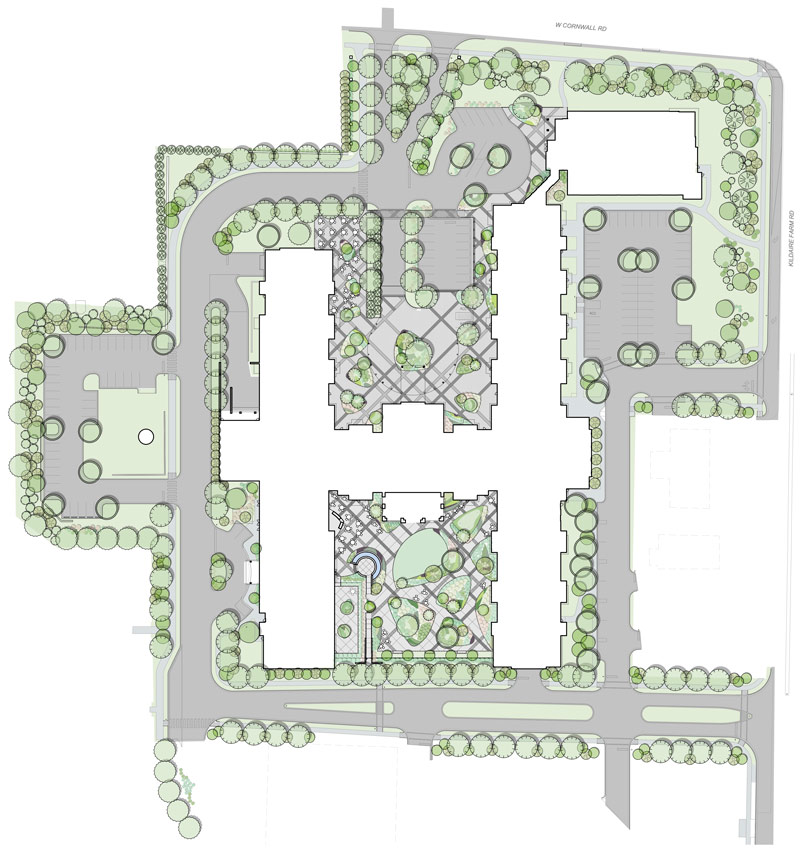
Glenaire Retirement Community in Cary, North Carolina. Courtesy of Surface 678.
Scott Lebsack, PLA, ASLA, Landscape Architect at BYLA
I came to realize that AutoCAD wasn’t using the resources available in a modern computer. It only allowed me to draft with a set of digital tools that mimicked the physical tools I was familiar with. It only nodded at modeling, which wasn’t easy to use. I tried to use block attributes to create plant schedules and “smart irrigation” blocks, but the tools for creating and interacting with extra data weren’t well implemented and didn’t seem to be encouraged.
Why did you decide on Vectorworks Landmark?
Jordan Guerrero (SiteWorks) — Vectorworks Landmark is very finely tuned to the needs of landscape architects in terms of tools and features. We were also really drawn to having an all-in-one solution, one that enables BIM workflows, too, because other countries are already requiring it and now it’s coming to us.
Phillip Tripp (Surface 678) — The lightbulb moment was realizing Vectorworks designed Landmark specifically for landscape architects, with native tools and features that are integral to our process. In contrast, with AutoCAD, we’d have to invest in separate add-on applications for each license in the office.
Scott Lebsack (BYLA) — Having software that replaces SketchUp and provides tools specifically for planting, grading, and irrigation in a single package is critical for streamlining the work we do. Everything is contained in a single working file; my design and my model are the same thing. My time in Vectorworks is spent designing. I don’t “draft” anymore.
What’s the biggest difference you experience in your everyday workflows?
Jordan Guerrero (SiteWorks) — The biggest thing for us is being able to do digital terrain modeling for cut/fill analysis. Our ultimate goal is to lead our practice with technology, and the landscape-focused features in Vectorworks Landmark allow us to do that.
Phillip Tripp (Surface 678) — There are three big changes I’d call out. The first is replacing AutoCAD files with references to allow multiple people to work simultaneously with a single Vectorworks Project Sharing file.
The second is capitalizing on the dual system of organizing data — classes and layers — to exponentially increase our ability to develop conceptual options quickly in a clear and manageable way, from simple diagrams to full construction alternates; all while simultaneously keeping presentation quality graphics current without ever leaving Vectorworks. Additionally, our more complex projects are using Vectorworks site modeling and freeform modeling features in conjunction with Twinmotion to produce highly detailed flythrough videos for clients, without the need to use SketchUp or Rhino.
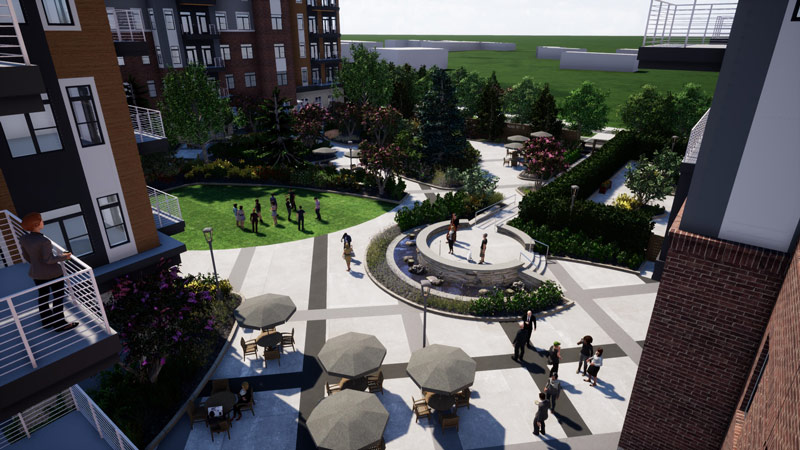
Glenaire Retirement Community in Cary, North Carolina. Courtesy of Surface 678.
The third is the use of Vectorworks’ resource library to actively manage our plant library and detail library, which improves our ability to provide quality assurance standards across all projects — a Vectorworks benefit that will continue to improve as we expand our office standards.
Scott Lebsack (BYLA) — Modeling and plant tools are the biggest improvements. I haven’t had to manually count plants in several years. I’m able to model a project and cut sections and elevations to show different aspects that change with the project. Ultimately, the largest change (which is a very simple one) is having fills associated with lines. I haven’t spent time in several years struggling to hatch something.
In what ways does Vectorworks Landmark help you perform your job responsibilities to the highest level?
Jordan Guerrero (SiteWorks) — When we look at a site model, we’re really focusing on the real-world implications of how everything interacts. That’s why digital terrain modeling and cut/fill analysis are so important to us. They allow us to better understand the site, its elevations, and what those elevations mean when it comes to design services.
Phillip Tripp (Surface 678) — Exceeding client expectations requires success in multiple ways; but in general, it’s high quality graphics and options in a timely manner which Vectorworks has proven more than capable, including expanding our services from high end perspectives to complete models, which clients have used for marketing in every case.
Scott Lebsack (BYLA) — Plant tools, worksheets, class and layer management all streamline the work I do every day. They allow me to be more efficient with my time and more consistent with my drawings.
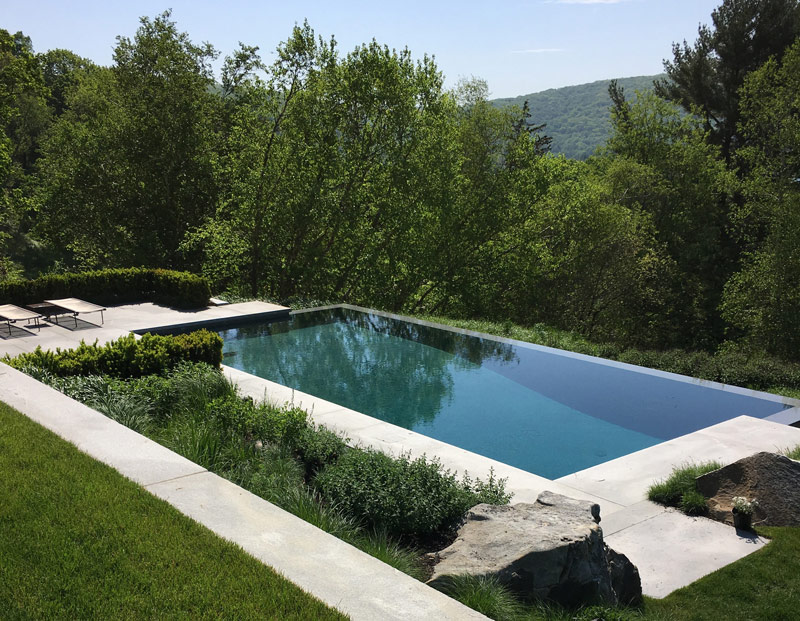
Poolside Patio courtesy of BYLA.
Have there been any challenges since switching? If so, how have you addressed them?
Jordan Guerrero (SiteWorks) — We have to be very open about our software choice when working with other firms. It’s been important to talk it out at the beginning and determine proper file types. It’s just about assuring firms that our using Vectorworks isn’t going to change their workflow. Although there are many file types to collaborate with, the translation of information isn’t always seamless. We find that it sometimes requires testing with clients to find an agreeable file type to work with.
Phillip Tripp (Surface 678) — An anticipated growing pain is that new hires are typically unfamiliar with Vectorworks and require in-office training during orientation and continued assistance through office mentors for the first couple months.
We work around this with Project Sharing. All production staff on a project can see the efforts of their peers and can identify when new hires would benefit from reminders on techniques or office standards. We’re optimistic that universities will expand their software options within the landscape architecture program and offer access or training courses in Vectorworks, as this skill set would be highly valued.
Scott Lebsack (BYLA) — We’ve struggled with speed on some repetitive drafting activities. That said, the Vectorworks development team has been very responsive to user feedback when it comes to improving the software. We’ve pushed feature requests in Vectorworks’ forum that we hope to see implemented.
—
Vectorworks is a major sponsor of Land8.
Login
Lost Password
Register
Follow the steps to reset your password. It may be the same as your old one.












